Logistics and Supply Chain Management Report: Apple Inc. UK Case
VerifiedAdded on 2023/06/15
|7
|1552
|110
Report
AI Summary
This report provides an analysis of logistics and supply chain management, focusing on Apple Inc.'s UK operations. It discusses the core concepts of logistics, including reverse logistics, and emphasizes the importance of integrating Information and Communication Technology (ICT) to reduce operational costs. The paper reviews relevant literature, highlighting how logistics extends beyond mere transportation to encompass the entire supply chain, impacting both cost-effectiveness and a company's reputation. Apple's strategic approach to supply chain management, such as leveraging Chinese manufacturing plants and direct customer delivery, is examined to illustrate effective cost reduction and competitive advantage. The report concludes that a robust logistics operation is crucial for minimizing costs and enhancing overall supply chain efficiency.
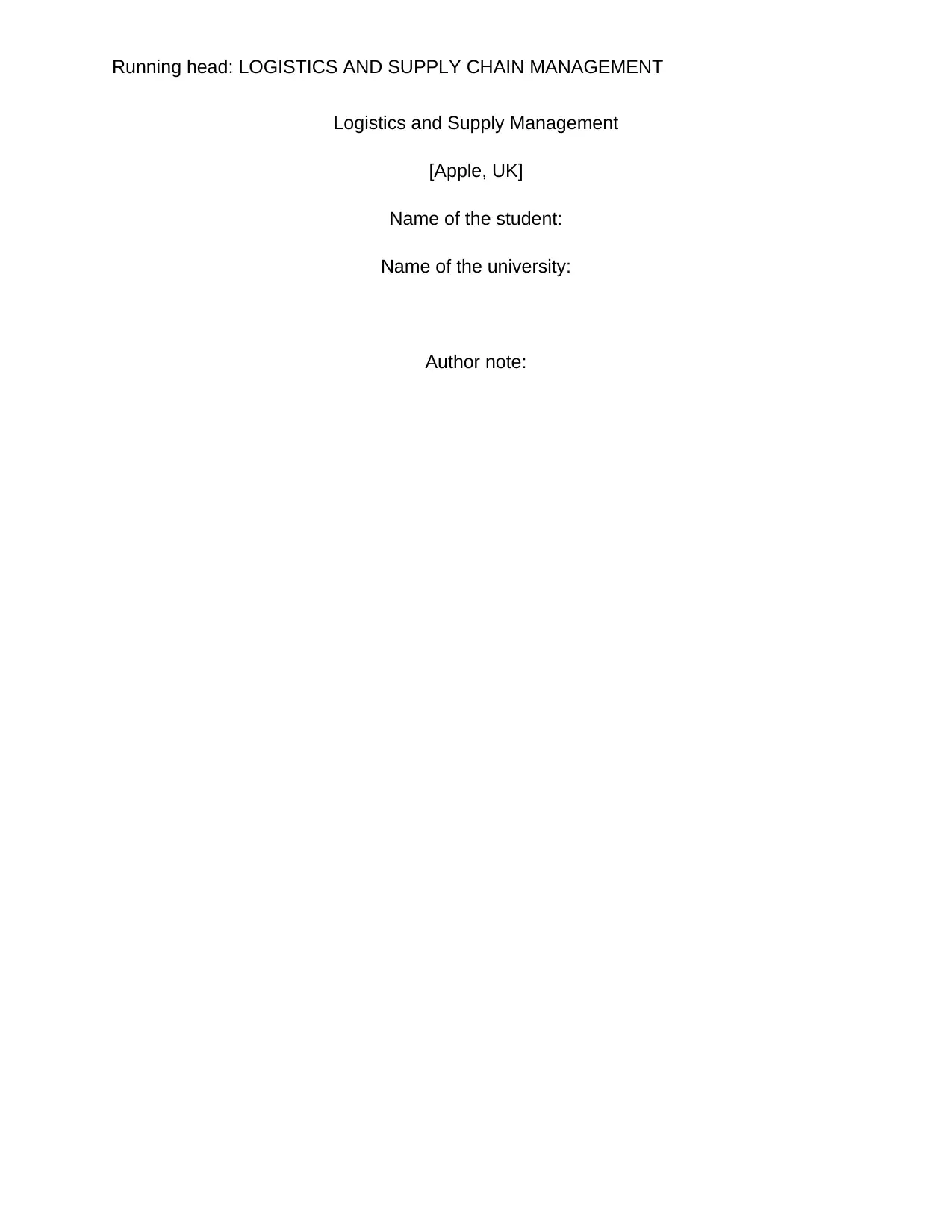
Running head: LOGISTICS AND SUPPLY CHAIN MANAGEMENT
Logistics and Supply Management
[Apple, UK]
Name of the student:
Name of the university:
Author note:
Logistics and Supply Management
[Apple, UK]
Name of the student:
Name of the university:
Author note:
Paraphrase This Document
Need a fresh take? Get an instant paraphrase of this document with our AI Paraphraser
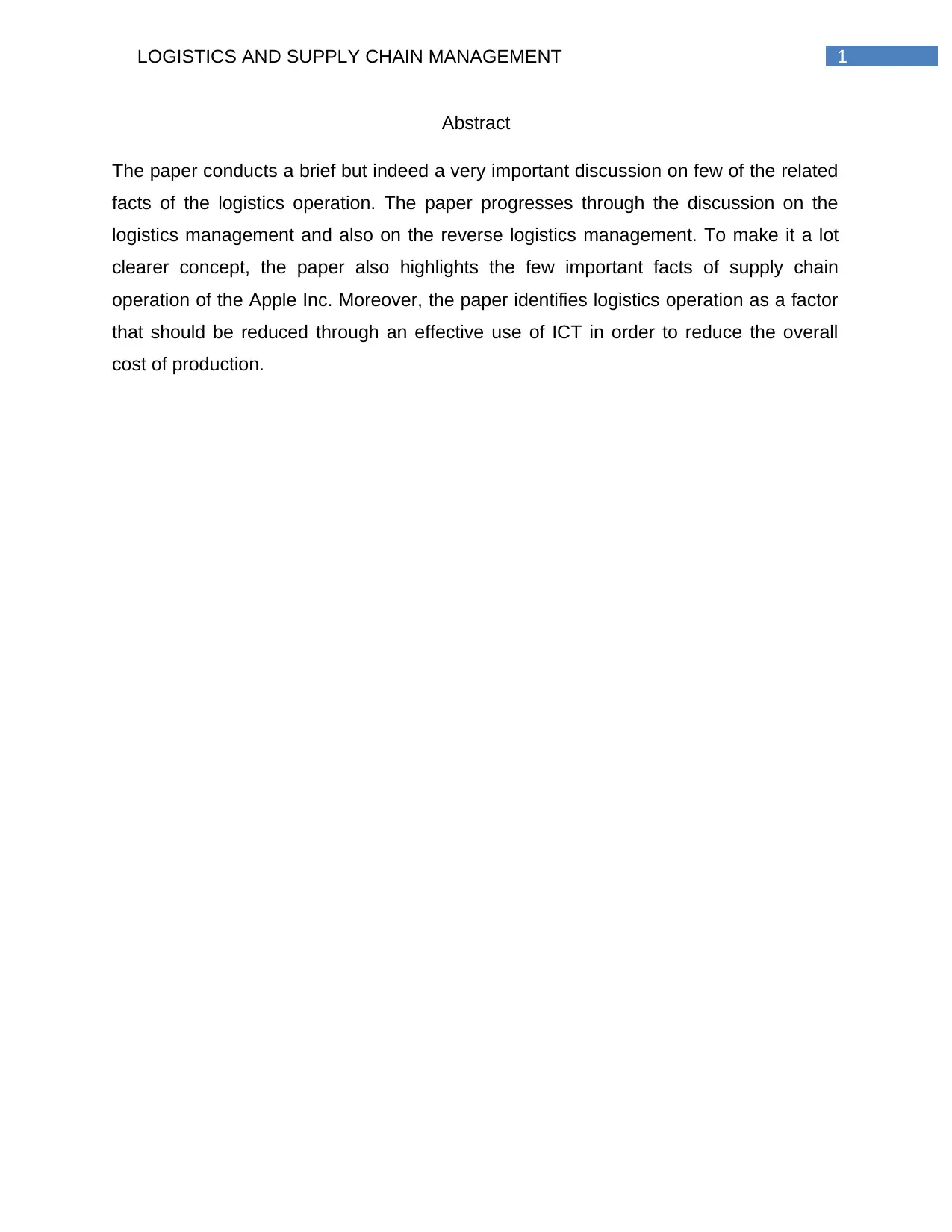
1LOGISTICS AND SUPPLY CHAIN MANAGEMENT
Abstract
The paper conducts a brief but indeed a very important discussion on few of the related
facts of the logistics operation. The paper progresses through the discussion on the
logistics management and also on the reverse logistics management. To make it a lot
clearer concept, the paper also highlights the few important facts of supply chain
operation of the Apple Inc. Moreover, the paper identifies logistics operation as a factor
that should be reduced through an effective use of ICT in order to reduce the overall
cost of production.
Abstract
The paper conducts a brief but indeed a very important discussion on few of the related
facts of the logistics operation. The paper progresses through the discussion on the
logistics management and also on the reverse logistics management. To make it a lot
clearer concept, the paper also highlights the few important facts of supply chain
operation of the Apple Inc. Moreover, the paper identifies logistics operation as a factor
that should be reduced through an effective use of ICT in order to reduce the overall
cost of production.
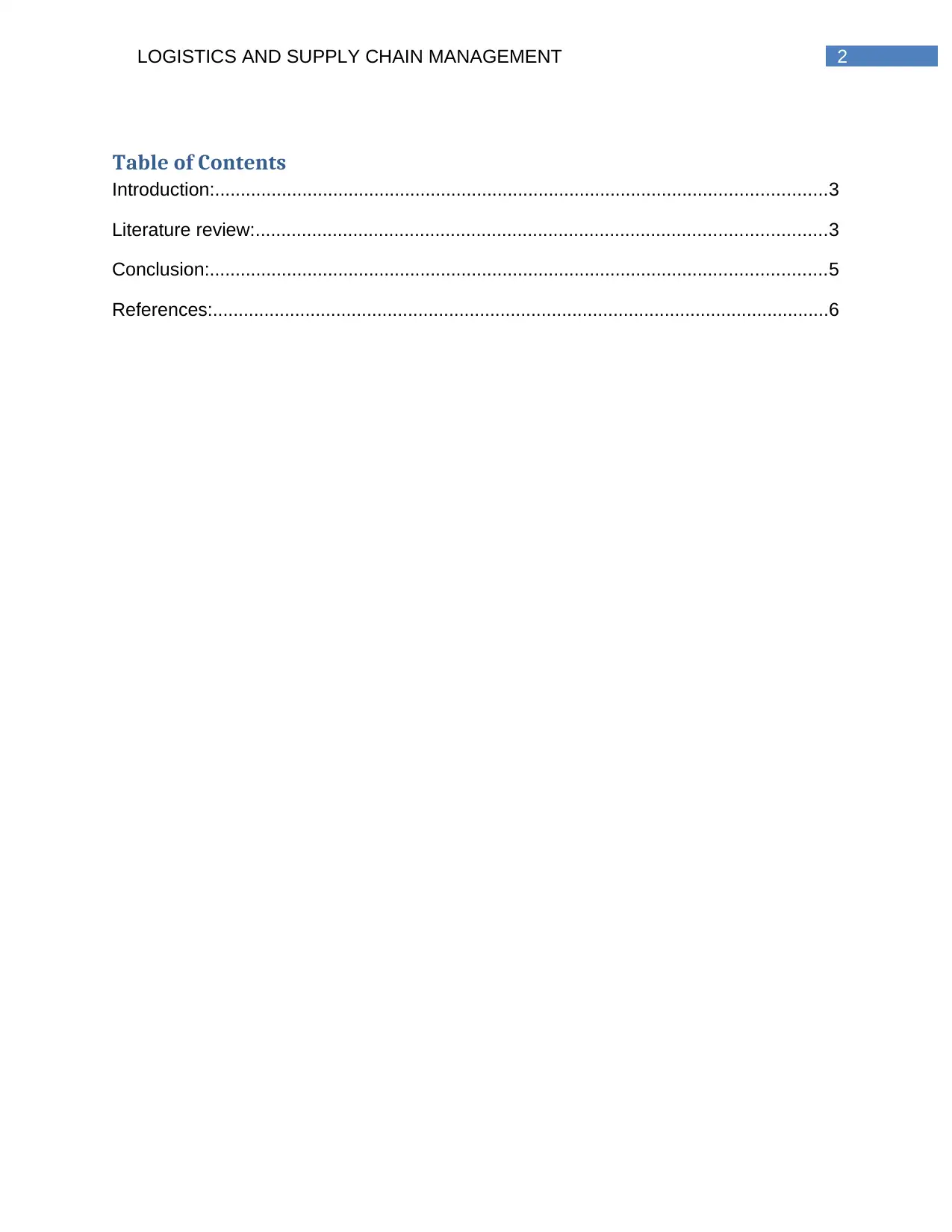
2LOGISTICS AND SUPPLY CHAIN MANAGEMENT
Table of Contents
Introduction:.......................................................................................................................3
Literature review:...............................................................................................................3
Conclusion:........................................................................................................................5
References:........................................................................................................................6
Table of Contents
Introduction:.......................................................................................................................3
Literature review:...............................................................................................................3
Conclusion:........................................................................................................................5
References:........................................................................................................................6
⊘ This is a preview!⊘
Do you want full access?
Subscribe today to unlock all pages.

Trusted by 1+ million students worldwide
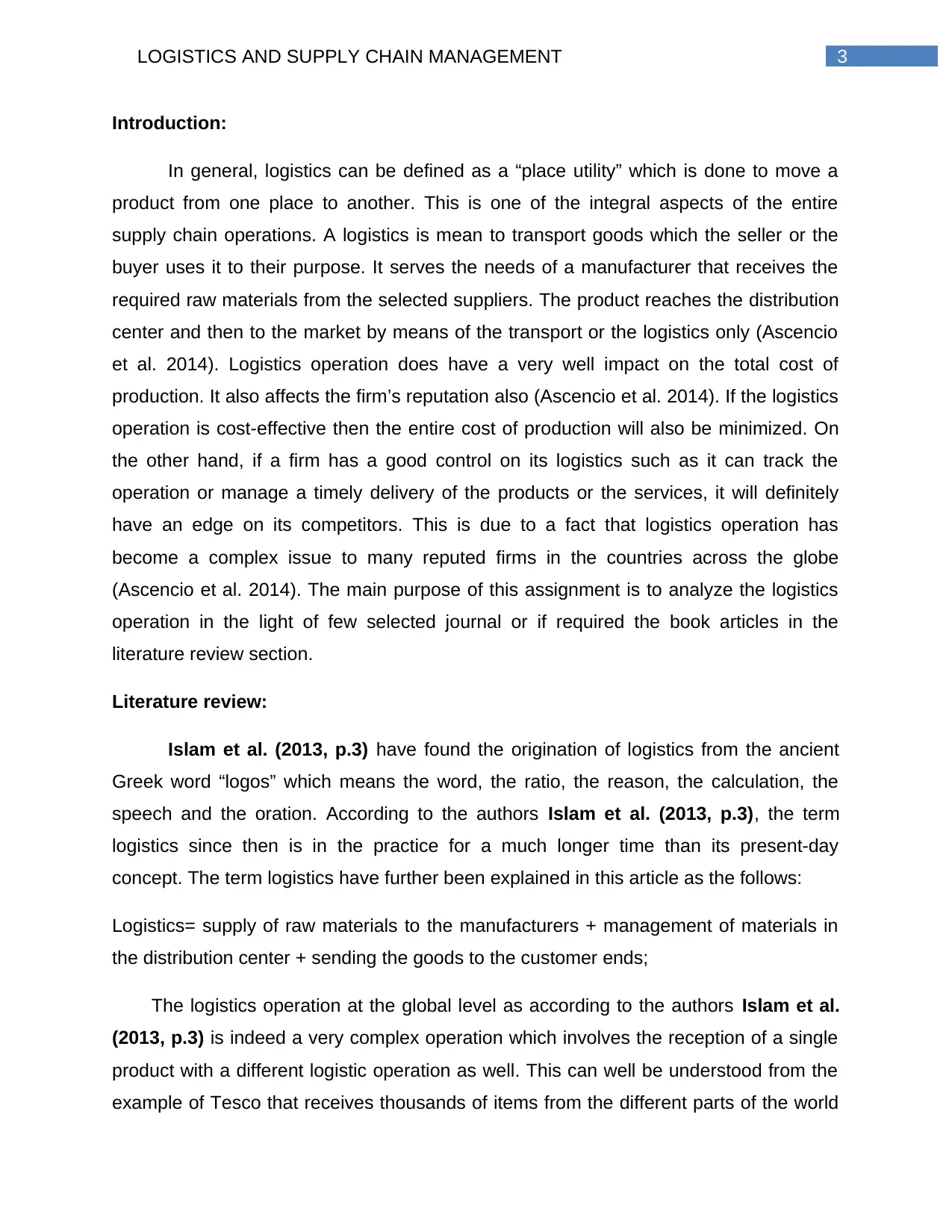
3LOGISTICS AND SUPPLY CHAIN MANAGEMENT
Introduction:
In general, logistics can be defined as a “place utility” which is done to move a
product from one place to another. This is one of the integral aspects of the entire
supply chain operations. A logistics is mean to transport goods which the seller or the
buyer uses it to their purpose. It serves the needs of a manufacturer that receives the
required raw materials from the selected suppliers. The product reaches the distribution
center and then to the market by means of the transport or the logistics only (Ascencio
et al. 2014). Logistics operation does have a very well impact on the total cost of
production. It also affects the firm’s reputation also (Ascencio et al. 2014). If the logistics
operation is cost-effective then the entire cost of production will also be minimized. On
the other hand, if a firm has a good control on its logistics such as it can track the
operation or manage a timely delivery of the products or the services, it will definitely
have an edge on its competitors. This is due to a fact that logistics operation has
become a complex issue to many reputed firms in the countries across the globe
(Ascencio et al. 2014). The main purpose of this assignment is to analyze the logistics
operation in the light of few selected journal or if required the book articles in the
literature review section.
Literature review:
Islam et al. (2013, p.3) have found the origination of logistics from the ancient
Greek word “logos” which means the word, the ratio, the reason, the calculation, the
speech and the oration. According to the authors Islam et al. (2013, p.3), the term
logistics since then is in the practice for a much longer time than its present-day
concept. The term logistics have further been explained in this article as the follows:
Logistics= supply of raw materials to the manufacturers + management of materials in
the distribution center + sending the goods to the customer ends;
The logistics operation at the global level as according to the authors Islam et al.
(2013, p.3) is indeed a very complex operation which involves the reception of a single
product with a different logistic operation as well. This can well be understood from the
example of Tesco that receives thousands of items from the different parts of the world
Introduction:
In general, logistics can be defined as a “place utility” which is done to move a
product from one place to another. This is one of the integral aspects of the entire
supply chain operations. A logistics is mean to transport goods which the seller or the
buyer uses it to their purpose. It serves the needs of a manufacturer that receives the
required raw materials from the selected suppliers. The product reaches the distribution
center and then to the market by means of the transport or the logistics only (Ascencio
et al. 2014). Logistics operation does have a very well impact on the total cost of
production. It also affects the firm’s reputation also (Ascencio et al. 2014). If the logistics
operation is cost-effective then the entire cost of production will also be minimized. On
the other hand, if a firm has a good control on its logistics such as it can track the
operation or manage a timely delivery of the products or the services, it will definitely
have an edge on its competitors. This is due to a fact that logistics operation has
become a complex issue to many reputed firms in the countries across the globe
(Ascencio et al. 2014). The main purpose of this assignment is to analyze the logistics
operation in the light of few selected journal or if required the book articles in the
literature review section.
Literature review:
Islam et al. (2013, p.3) have found the origination of logistics from the ancient
Greek word “logos” which means the word, the ratio, the reason, the calculation, the
speech and the oration. According to the authors Islam et al. (2013, p.3), the term
logistics since then is in the practice for a much longer time than its present-day
concept. The term logistics have further been explained in this article as the follows:
Logistics= supply of raw materials to the manufacturers + management of materials in
the distribution center + sending the goods to the customer ends;
The logistics operation at the global level as according to the authors Islam et al.
(2013, p.3) is indeed a very complex operation which involves the reception of a single
product with a different logistic operation as well. This can well be understood from the
example of Tesco that receives thousands of items from the different parts of the world
Paraphrase This Document
Need a fresh take? Get an instant paraphrase of this document with our AI Paraphraser
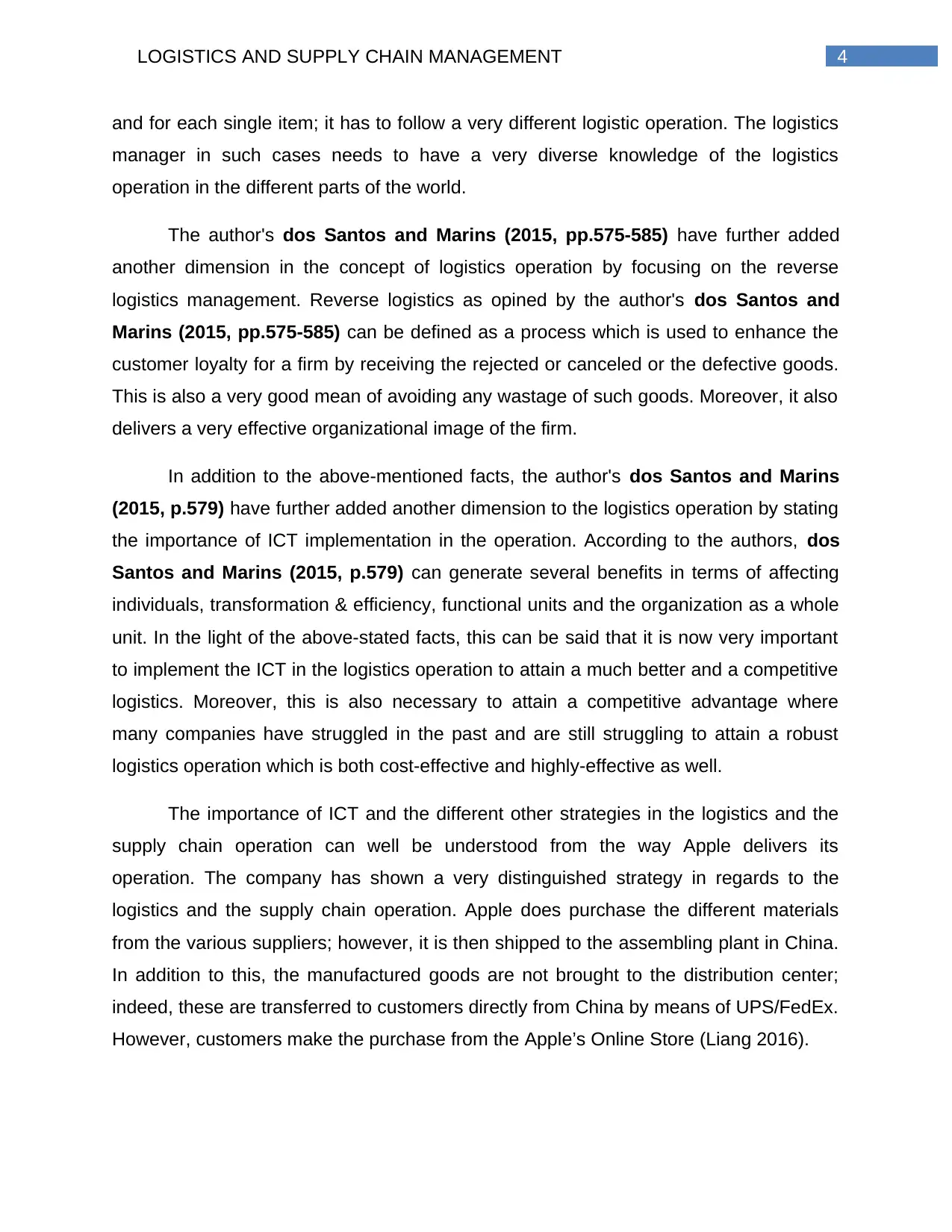
4LOGISTICS AND SUPPLY CHAIN MANAGEMENT
and for each single item; it has to follow a very different logistic operation. The logistics
manager in such cases needs to have a very diverse knowledge of the logistics
operation in the different parts of the world.
The author's dos Santos and Marins (2015, pp.575-585) have further added
another dimension in the concept of logistics operation by focusing on the reverse
logistics management. Reverse logistics as opined by the author's dos Santos and
Marins (2015, pp.575-585) can be defined as a process which is used to enhance the
customer loyalty for a firm by receiving the rejected or canceled or the defective goods.
This is also a very good mean of avoiding any wastage of such goods. Moreover, it also
delivers a very effective organizational image of the firm.
In addition to the above-mentioned facts, the author's dos Santos and Marins
(2015, p.579) have further added another dimension to the logistics operation by stating
the importance of ICT implementation in the operation. According to the authors, dos
Santos and Marins (2015, p.579) can generate several benefits in terms of affecting
individuals, transformation & efficiency, functional units and the organization as a whole
unit. In the light of the above-stated facts, this can be said that it is now very important
to implement the ICT in the logistics operation to attain a much better and a competitive
logistics. Moreover, this is also necessary to attain a competitive advantage where
many companies have struggled in the past and are still struggling to attain a robust
logistics operation which is both cost-effective and highly-effective as well.
The importance of ICT and the different other strategies in the logistics and the
supply chain operation can well be understood from the way Apple delivers its
operation. The company has shown a very distinguished strategy in regards to the
logistics and the supply chain operation. Apple does purchase the different materials
from the various suppliers; however, it is then shipped to the assembling plant in China.
In addition to this, the manufactured goods are not brought to the distribution center;
indeed, these are transferred to customers directly from China by means of UPS/FedEx.
However, customers make the purchase from the Apple’s Online Store (Liang 2016).
and for each single item; it has to follow a very different logistic operation. The logistics
manager in such cases needs to have a very diverse knowledge of the logistics
operation in the different parts of the world.
The author's dos Santos and Marins (2015, pp.575-585) have further added
another dimension in the concept of logistics operation by focusing on the reverse
logistics management. Reverse logistics as opined by the author's dos Santos and
Marins (2015, pp.575-585) can be defined as a process which is used to enhance the
customer loyalty for a firm by receiving the rejected or canceled or the defective goods.
This is also a very good mean of avoiding any wastage of such goods. Moreover, it also
delivers a very effective organizational image of the firm.
In addition to the above-mentioned facts, the author's dos Santos and Marins
(2015, p.579) have further added another dimension to the logistics operation by stating
the importance of ICT implementation in the operation. According to the authors, dos
Santos and Marins (2015, p.579) can generate several benefits in terms of affecting
individuals, transformation & efficiency, functional units and the organization as a whole
unit. In the light of the above-stated facts, this can be said that it is now very important
to implement the ICT in the logistics operation to attain a much better and a competitive
logistics. Moreover, this is also necessary to attain a competitive advantage where
many companies have struggled in the past and are still struggling to attain a robust
logistics operation which is both cost-effective and highly-effective as well.
The importance of ICT and the different other strategies in the logistics and the
supply chain operation can well be understood from the way Apple delivers its
operation. The company has shown a very distinguished strategy in regards to the
logistics and the supply chain operation. Apple does purchase the different materials
from the various suppliers; however, it is then shipped to the assembling plant in China.
In addition to this, the manufactured goods are not brought to the distribution center;
indeed, these are transferred to customers directly from China by means of UPS/FedEx.
However, customers make the purchase from the Apple’s Online Store (Liang 2016).
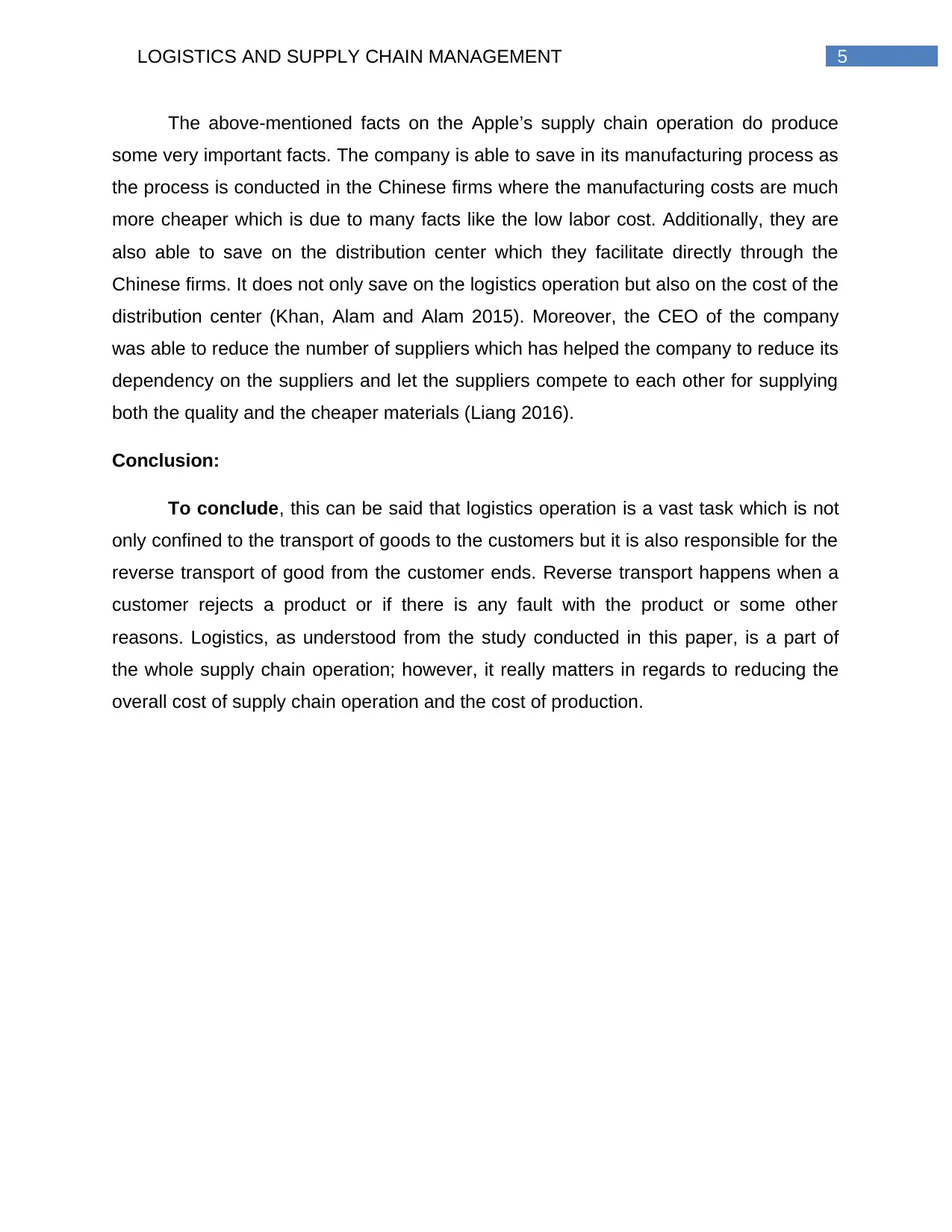
5LOGISTICS AND SUPPLY CHAIN MANAGEMENT
The above-mentioned facts on the Apple’s supply chain operation do produce
some very important facts. The company is able to save in its manufacturing process as
the process is conducted in the Chinese firms where the manufacturing costs are much
more cheaper which is due to many facts like the low labor cost. Additionally, they are
also able to save on the distribution center which they facilitate directly through the
Chinese firms. It does not only save on the logistics operation but also on the cost of the
distribution center (Khan, Alam and Alam 2015). Moreover, the CEO of the company
was able to reduce the number of suppliers which has helped the company to reduce its
dependency on the suppliers and let the suppliers compete to each other for supplying
both the quality and the cheaper materials (Liang 2016).
Conclusion:
To conclude, this can be said that logistics operation is a vast task which is not
only confined to the transport of goods to the customers but it is also responsible for the
reverse transport of good from the customer ends. Reverse transport happens when a
customer rejects a product or if there is any fault with the product or some other
reasons. Logistics, as understood from the study conducted in this paper, is a part of
the whole supply chain operation; however, it really matters in regards to reducing the
overall cost of supply chain operation and the cost of production.
The above-mentioned facts on the Apple’s supply chain operation do produce
some very important facts. The company is able to save in its manufacturing process as
the process is conducted in the Chinese firms where the manufacturing costs are much
more cheaper which is due to many facts like the low labor cost. Additionally, they are
also able to save on the distribution center which they facilitate directly through the
Chinese firms. It does not only save on the logistics operation but also on the cost of the
distribution center (Khan, Alam and Alam 2015). Moreover, the CEO of the company
was able to reduce the number of suppliers which has helped the company to reduce its
dependency on the suppliers and let the suppliers compete to each other for supplying
both the quality and the cheaper materials (Liang 2016).
Conclusion:
To conclude, this can be said that logistics operation is a vast task which is not
only confined to the transport of goods to the customers but it is also responsible for the
reverse transport of good from the customer ends. Reverse transport happens when a
customer rejects a product or if there is any fault with the product or some other
reasons. Logistics, as understood from the study conducted in this paper, is a part of
the whole supply chain operation; however, it really matters in regards to reducing the
overall cost of supply chain operation and the cost of production.
⊘ This is a preview!⊘
Do you want full access?
Subscribe today to unlock all pages.

Trusted by 1+ million students worldwide
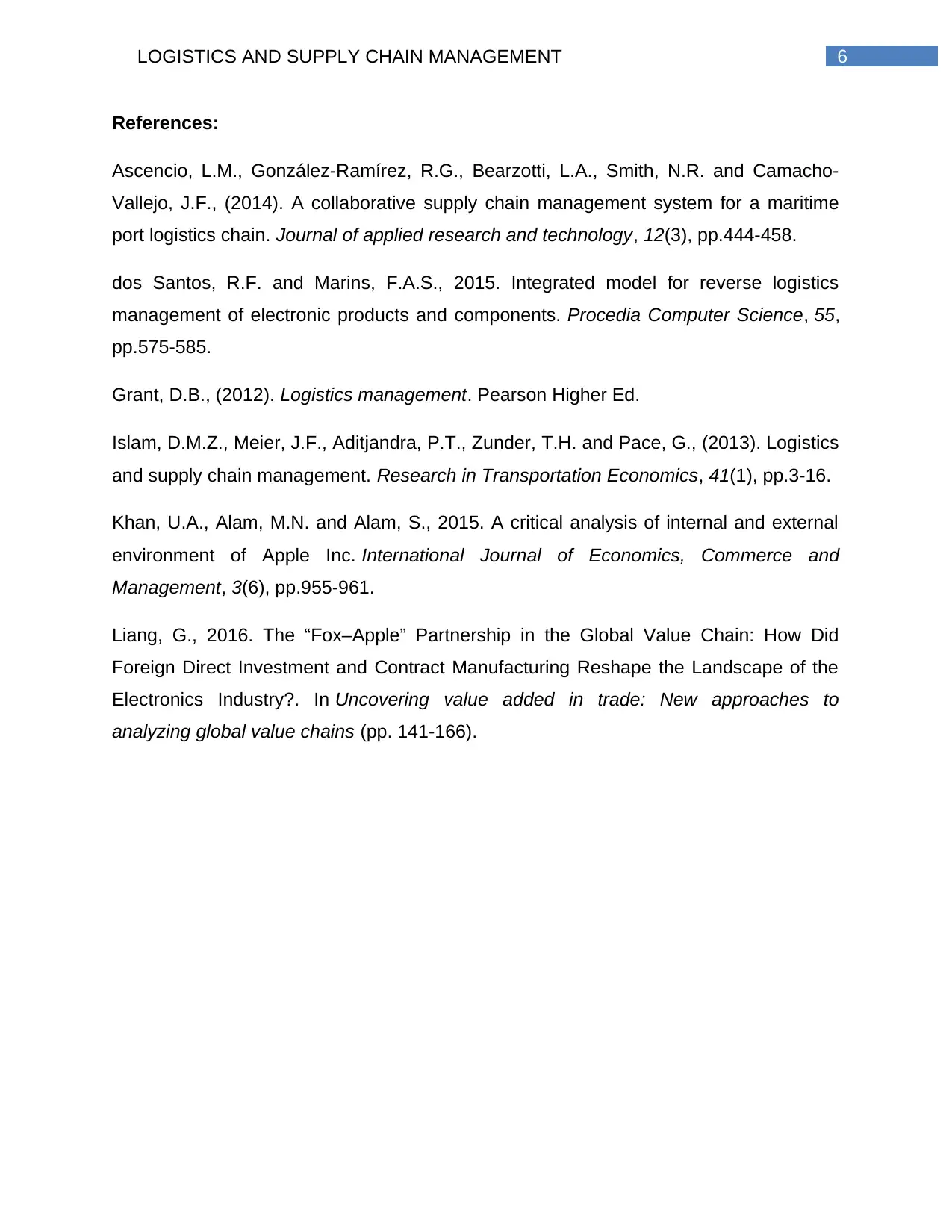
6LOGISTICS AND SUPPLY CHAIN MANAGEMENT
References:
Ascencio, L.M., González-Ramírez, R.G., Bearzotti, L.A., Smith, N.R. and Camacho-
Vallejo, J.F., (2014). A collaborative supply chain management system for a maritime
port logistics chain. Journal of applied research and technology, 12(3), pp.444-458.
dos Santos, R.F. and Marins, F.A.S., 2015. Integrated model for reverse logistics
management of electronic products and components. Procedia Computer Science, 55,
pp.575-585.
Grant, D.B., (2012). Logistics management. Pearson Higher Ed.
Islam, D.M.Z., Meier, J.F., Aditjandra, P.T., Zunder, T.H. and Pace, G., (2013). Logistics
and supply chain management. Research in Transportation Economics, 41(1), pp.3-16.
Khan, U.A., Alam, M.N. and Alam, S., 2015. A critical analysis of internal and external
environment of Apple Inc. International Journal of Economics, Commerce and
Management, 3(6), pp.955-961.
Liang, G., 2016. The “Fox–Apple” Partnership in the Global Value Chain: How Did
Foreign Direct Investment and Contract Manufacturing Reshape the Landscape of the
Electronics Industry?. In Uncovering value added in trade: New approaches to
analyzing global value chains (pp. 141-166).
References:
Ascencio, L.M., González-Ramírez, R.G., Bearzotti, L.A., Smith, N.R. and Camacho-
Vallejo, J.F., (2014). A collaborative supply chain management system for a maritime
port logistics chain. Journal of applied research and technology, 12(3), pp.444-458.
dos Santos, R.F. and Marins, F.A.S., 2015. Integrated model for reverse logistics
management of electronic products and components. Procedia Computer Science, 55,
pp.575-585.
Grant, D.B., (2012). Logistics management. Pearson Higher Ed.
Islam, D.M.Z., Meier, J.F., Aditjandra, P.T., Zunder, T.H. and Pace, G., (2013). Logistics
and supply chain management. Research in Transportation Economics, 41(1), pp.3-16.
Khan, U.A., Alam, M.N. and Alam, S., 2015. A critical analysis of internal and external
environment of Apple Inc. International Journal of Economics, Commerce and
Management, 3(6), pp.955-961.
Liang, G., 2016. The “Fox–Apple” Partnership in the Global Value Chain: How Did
Foreign Direct Investment and Contract Manufacturing Reshape the Landscape of the
Electronics Industry?. In Uncovering value added in trade: New approaches to
analyzing global value chains (pp. 141-166).
1 out of 7
Related Documents
Your All-in-One AI-Powered Toolkit for Academic Success.
+13062052269
info@desklib.com
Available 24*7 on WhatsApp / Email
![[object Object]](/_next/static/media/star-bottom.7253800d.svg)
Unlock your academic potential
Copyright © 2020–2025 A2Z Services. All Rights Reserved. Developed and managed by ZUCOL.





